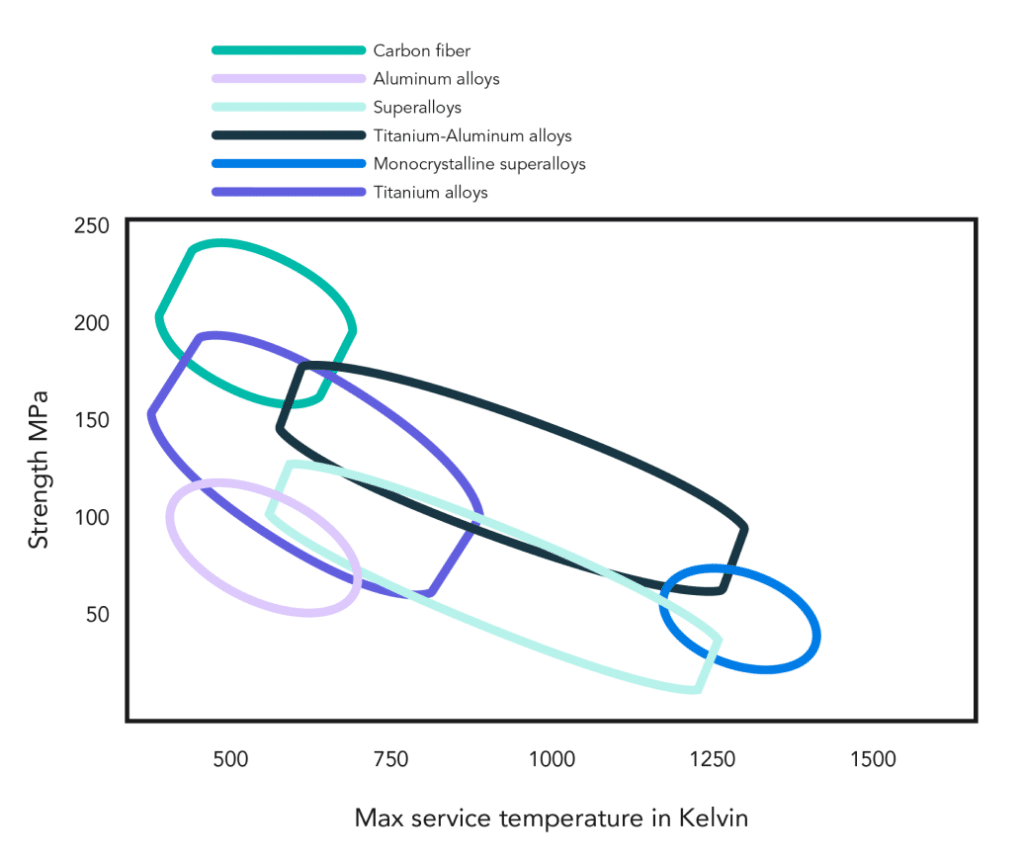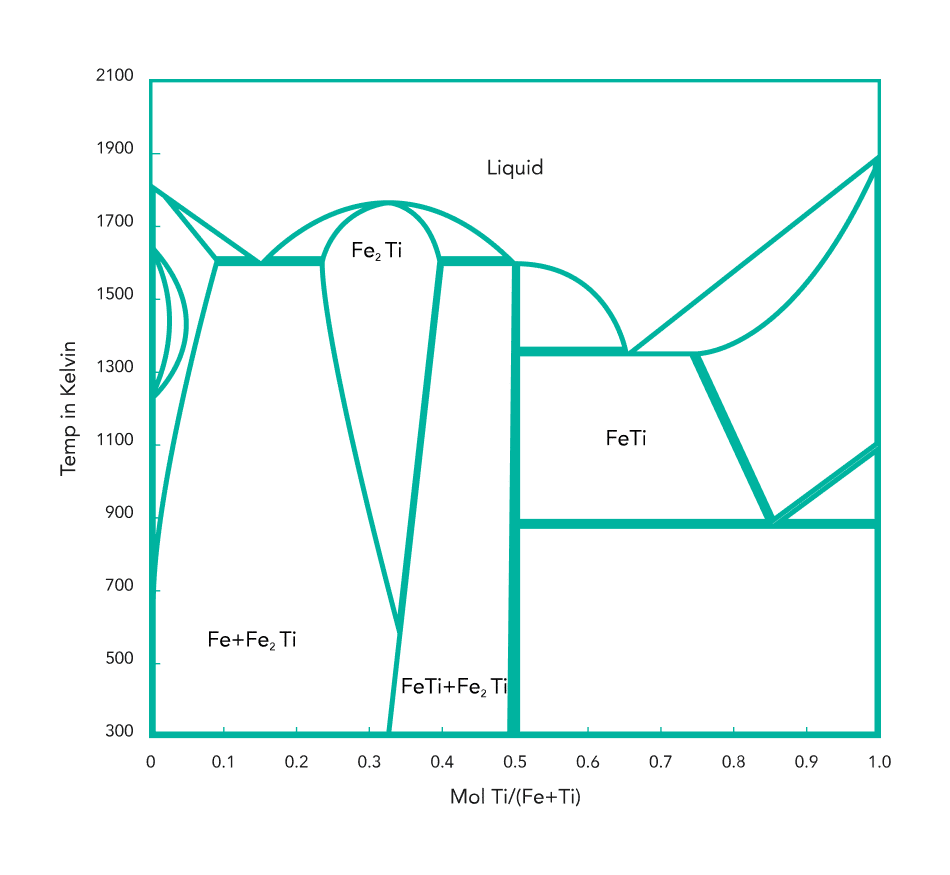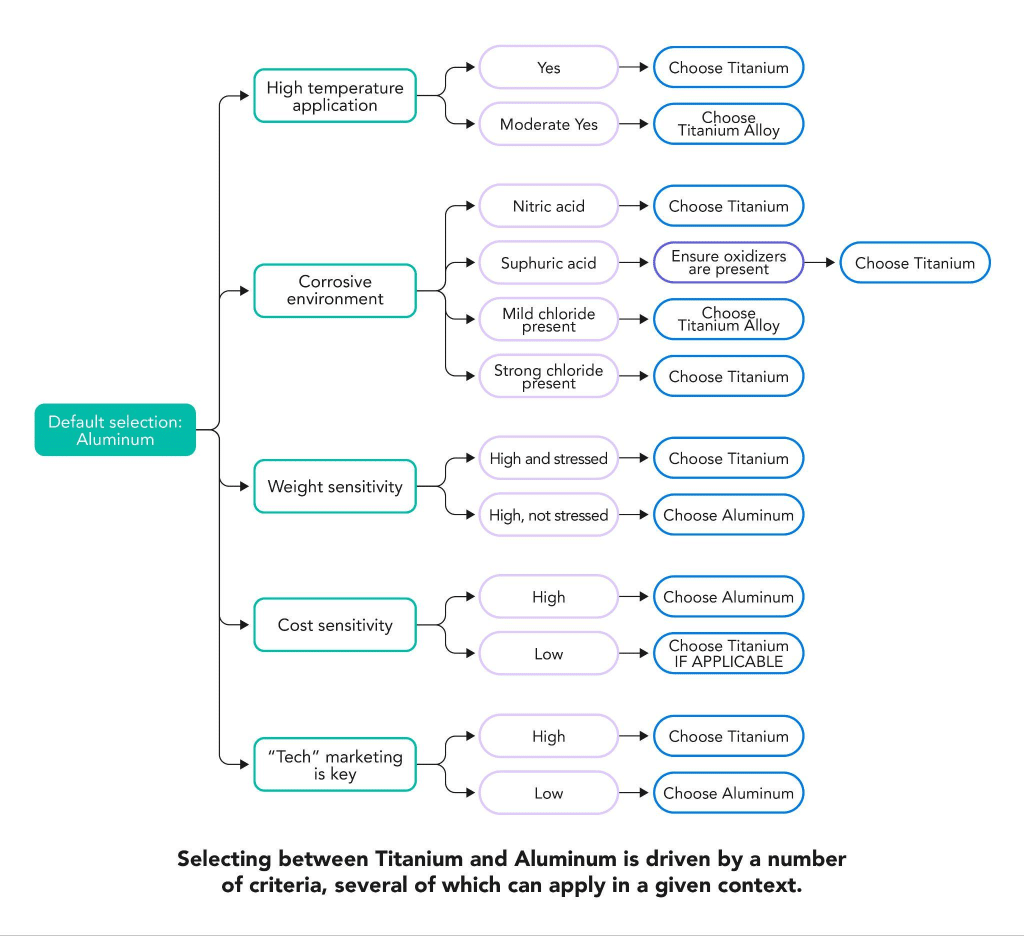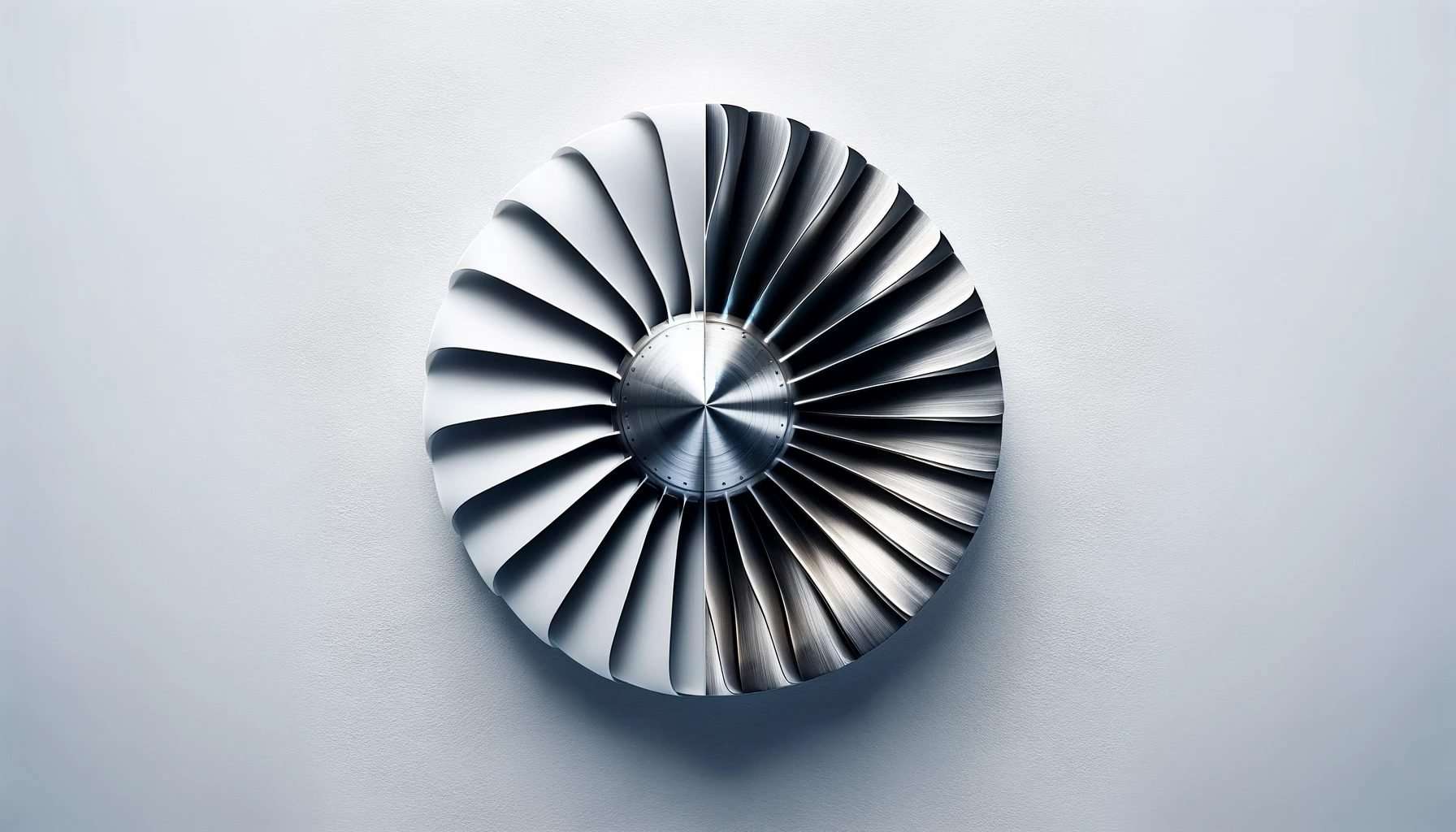Titanium and Aluminum are both lightweight metals with distinct properties and versatility of application.
- Titanium properties – Titanium is known for its exceptional strength-to-weight ratio, corrosion resistance, and biocompatibility. It has a low density, high melting point, and excellent heat and chemical resistance.
- Titanium applications – It is widely used for aircraft, rocket, satellite and engine components for its low weight and high strength. It’s used in artificial joints and dental implants, for biocompatibility. It’s employed for lightweight and high-performance auto parts, sports equipment, chemical processing, and the marine industry.

Typical Titanium application in a prosthetic lower leg, where weight and extreme strength are major factors
- Aluminum properties – Aluminum is lightweight, corrosion-resistant and has good electrical and thermal conductivity. It’s malleable and is readily alloyed.
- Aluminum applications – Aluminum is extensively used for windows, doors and cladding due to its corrosion resistance. It’s used for vehicle and trailer bodies, aircraft frames and skins, sports gear, cooking equipment etc. It’s also used for cans and foils in packaging, electrical wiring and heat exchangers.

These materials offer unique and overlapping benefits and they’re both essential engineering materials.
Importance of comparing titanium and aluminum
Comparing Titanium and Aluminum is useful for several reasons. Engineers will choose the most suitable material for specific applications based on required properties
- Weight and strength trade-offs – comparing their strength-to-weight ratios can determine which material is optimal for lightness or high-strength.
- Corrosion resistance – corrosion resistance properties are crucial where harsh environment exposure is a factor.
- Cost considerations – cost plays a part in material selection.
- Sector specifics – industries may have specific requirements that require compliance.
- Environmental impact – evaluating recyclability/sustainability is usually required.
- Manufacturability – ease of fabrication and volume suitability of the manufacturing process is key.
Strength and Weight
Titanium's high strength-to-weight ratio
Titanium is valued for its exceptional strength-to-weight ratio, which is one of its most important properties. Despite being notably strong, Titanium is very lightweight, making it highly sought after in industries where weight reduction is critical and cost sensitivity is less so.
This is optimal for aerospace applications, like aircraft spacecraft stress parts, where minimizing weight while maximizing structural integrity is paramount. High strength-to-weight ratio helps in medical implants, sporting equipment and military applications.
Aluminum's wide range of applications due to its strength
Aluminum’s wide utility also largely results from strength-to-weight ratio. It is indispensable in industries where weight efficiency matters but cost control remains important. In transportation, Aluminum is used for lightweight vehicle bodies, aircraft components, and sports gear, reducing fuel/effort consumption and enhancing performance. In construction, it’s used in windows/doors and siding, offering strength without excessive weight or cost. The packaging industry relies on aluminum for lightweight cans and foils. Its electrical/thermal conductivity makes it suitable for electrical wiring, heat exchangers and various industrial components.
Comparison of tensile strength between titanium and aluminum
Titanium generally exhibits a higher tensile strength compared to aluminum. The tensile strength of Titanium alloys can range from 345 to 1380 MPa (50,000 to 200,000 psi), depending on the specific alloy and heat treatment.
Aluminum alloys typically lie in the range of 140 to 480 MPa (20,000 to 70,000 psi). This is still a high strength, so a balance between application resilience, weight, total volume of parts and part cost (from material AND processing) will drive the selection.
Impact of material properties on strength
The strength of Aluminum and Titanium results directly from their alloying and properties;
- Aluminum has a face-centered cubic (FCC) crystal structure, while titanium has a hexagonal close-packed (HCP) crystal structure. The arrangement of atoms in these structures affects the dislocation movement and slip planes, ultimately influencing the materials’ strength. Titanium’s HCP structure prevents intra and inter crystalline slips, resulting in its higher strength than Aluminum.
- Smaller grain sizes generally result in stronger materials. Controlling grain size through processes like heat treatment enhances both Aluminum and Titanium.
- The addition of alloying elements can greatly impact the strength of both metals. Alloying Aluminum with elements like Copper, Zinc, or Magnesium can increase its strength. Similarly, Titanium alloys, such as Ti-6Al-4V, owe their superior strength to carefully chosen alloying elements.
- Heat treatment by quenching and tempering can alter the microstructure of Aluminum and Titanium by restraining or modifying grain size and inter granular properties to alter the balance between hardness and ductility.
- The ultimate strength of both materials is temperature-dependent. Titanium retains its strength at elevated temperatures (up to 550°C) better than Aluminum (typically up to 250°C), making it more suitable for high-temperature/high-strength applications.
- The presence of defects, impurities, or imperfections in the material’s structure can weaken both Aluminum and Titanium.

Usage and Applications
Titanium's ideal use in specific industries
Titanium is widely used across various industries due to unique properties and versatility. Some of the industries where titanium finds applications include:
- Aerospace – Titanium’s strength-to-weight ratio, corrosion resistance, and ability to withstand high temperatures make it vital in aerospace. It is used in aircraft/spacecraft components and jet/rocket engines reducing weight and improving performance.
- Medical – Titanium is biocompatible and corrosion-resistant, ideal material for medical implants such as artificial joints, dental implants, and surgical instruments.
- Chemical processing – Titanium’s corrosion resistance and resistance to aggressive chemicals make it suitable for chemical processing plants, heat exchangers, valves, and tanks.
- Military – Strength and durability make it a preferred choice for military applications, including armored vehicles, aircraft, and naval equipment.
- Sports equipment – Bicycle frames, golf clubs and tennis rackets benefit from lightweight and strength.
- Automotive – High-performance vehicle exhaust systems and suspension components, benefit from corrosion resistance, weight and strength.
- Oil and Gas – Oil platforms and equipment exposed to harsh marine environments benefit from corrosion resistance and strength.
- Desalination – Resistance to chloride corrosion facilitates desalination plant heat exchangers and pumps.
- Jewelry – Lightweight and hypoallergenic properties benefit jewelry design.
Aluminum's non-toxic nature and versatile applications
Aluminum’s low toxicity and versatility make it indispensable in various industries involving contact with food and beverages, such as packaging materials and kitchenware. High electrical and thermal conductivity properties make it essential in the electronics and electrical transmission for wiring and heat sinks. In construction, Aluminum’s corrosion resistance and low density serve in windows, doors and building frames. It is employed in vehicle bodies, airframes and skins and bicycle frames for weight reduction and fuel/effort efficiency.
Choice of application: titanium vs aluminum
Choosing between Aluminum and Titanium depends on the specific needs of each application.
- Aluminum is a cost-effective, lightweight material with high strength and lightweight, suitable for aerospace, automotive and sports equipment.
- Titanium is renowned for exceptional strength-to-weight, corrosion resistance and biocompatibility, suited to aerospace/engine, medical implants, and chemical processing.
- Consider factors like budget, weight constraints, strength requirements, and environmental conditions when selecting between these materials. Titanium is very high cost in both material and manufacturing, so it is only selected when the critical drivers are weight, chemical and temperature resistance and aesthetics.

Density and Weight Ratio
Titanium's lower density compared to aluminum
Titanium has a density of approximately 4.5 g/cm³, whereas Aluminum has a significantly lower density of about 2.7 g/cm³. Despite its higher density, Titanium is often chosen for applications where its superior strength-to-weight ratio, corrosion resistance, and other properties outweigh the weight factor, such as in aerospace, medical implants, sport equipment etc.
Impact of density on weight ratio
Aluminum is less dense than Titanium, but also weaker. Therefore a larger volume of Aluminum is required to achieve the same strength as Titanium.
- Aluminum strength to weight ratio is a maximum of 158 kN·m/k. This value is HIGHLY dependant on alloy and heat treatment/work hardening
- Titanium strength to weight ratio is 187 kN·m/kg
Where simple strength is the only factor, this differential is small and can be countered by good design. But add heat tolerance, corrosion resistance and weight as the most critical factor, the huge cost of Titanium becomes justified.

Benjamin S

Mechanical Engineer
"I wish this existed years ago!"
Jiga is the best way to get the parts you need, when you need them.
Advantages and disadvantages of aluminum
Aluminum is the widely made choice, between these two options. It has benefits but also issues that can rule it out.
- Aluminum is more cost-effective, making it a preferred choice for budget-conscious projects. It is better suited to high volume production as it is considerably easier to work.
- Its lower density makes it exceptionally lightweight, ideal for applications where weight reduction is critical but strength is not a prime concern.
- Excellent electrical and thermal conductivity and low cost make it suitable for long conductors and heat transfer applications.
- Aluminum is not as strong as titanium, limiting its use in high-stress applications.
- Aluminum is more susceptible to corrosion in aggressive environments, necessitating protective coatings.
- Aluminum’s strength diminishes at elevated temperatures.
- Aluminum may have a shorter lifespan, requiring more frequent replacement due to fatigue and wear properties.
Alloy elements and their influence on weight
Titanium alloys include a range of alloying agents;
- Aluminum in Titanium alloys contributes to reduced weight without excessive loss of strength.
- Vanadium enhances the alloy’s mechanical properties.
- Iron is often added to improve weldability.
- Titanium is included in some stainless steel alloys, to improve corrosion resistance.

These alloying elements are carefully balanced to maintain the inherent lightweight characteristic while enhancing its strength, corrosion resistance etc.
Aluminum alloys also include a diverse range of alloying agents.
- Aluminum-Magnesium alloys are lighter weight and more corrosion-resistant, making them suitable for aerospace/automotive applications.
- Copper-containing alloys offer increased strength.
- Silicon contributes to improved casting properties.
Balancing these elements allows for the development of alloys tailored to specific weight and performance requirements.
Thermal Conductivity and Corrosion Resistance
Aluminum's high thermal conductivity
Aluminum exhibits high thermal conductivity, making it ideal for applications where heat dissipation is critical, such as in heat sinks for electronics, automotive radiators, and cookware. This relies on chemically relatively benign environments, however.

Titanium's surface properties and corrosion resistance
Titanium offers exceptional corrosion resistance due to the formation of a very robust protective oxide layer on its surface. This surface also possesses a low coefficient of friction, making it resistant to galling and seizing.
Comparison of thermal conductivity between titanium and aluminum
Aluminum is an excellent conductor of heat, at 205-235 W/m·K depending on alloy and heat treatment. Titanium has a lower thermal conductivity, ranging from 6-20 W/m·K.
Titanium is not suited to applications where heat dissipation is required, though its high temperature tolerance can serve to compensate for this in some applications.
Importance of corrosion resistance in different applications
Corrosion resistance is vital in both Aluminum and Titanium applications for durability and safety. It extends the lifespan of components, reduces maintenance costs, and ensures structural integrity, especially in aerospace and automotive sectors.
The elevated chemical resilience of Titanium is exploited in chemical processing, medical implants, aerospace and marine applications, delivering functional reliability, biocompatibility and reduced maintenance burden.
In both materials, corrosion resistance influences application-efficiency, cost-effectiveness, and environmental impact, but care in understanding the response to the expected usage environment is key to a successful outcome.
Cost and Price
Titanium's higher cost compared to aluminum
Titanium has a spot price of US$5.75 per kg, at the point of writing. Aluminum currently trades at US$2.2 per kg. This differential is not simple, as material usage in any application is not weight comparable directly. More Aluminum is required for the same strength as Titanium in a particular application.
Selecting between the two materials can be a price driven decision, but more often the performance issues will drive a selection.
Factors to consider when evaluating cost-effectiveness
When evaluating the cost-effectiveness of choosing between aluminum and titanium, several crucial factors should be considered:
- Material costs – Balancing the material purchase cost effect.
- Processing – Take into account processing costs, which can be much greater than raw material costs – and can be X10 for Titanium compared with Aluminum.
- Weight savings – Does Titanium’s weight reduction benefit justify its higher cost.
- Chemical resilience – Does the application need exceptional corrosion endurance?
- Lifetime – Consider long-term maintenance and replacement costs, where titanium’s durability can represent long term value.
- Volume – Large-scale production can impact costs significantly, Aluminum is considerably easier to transition to high volume.
- Industry norms – Ensure compliance with industry standards and safety.
- Environmental impact – Analyze environmental regulations and disposal costs for lifecycle impact.

Sam H

Manufacturing Business Consultant
"Excellent platform for prototyping & manufacturing"
Jiga is the best way to get the parts you need, when you need them.
Other Factors to Consider
Linear thermal expansion and its implications
Differentials in linear thermal expansion coefficients are important where dimensional stability with temperature variations is crucial.
- Titanium has a relatively low coefficient of linear thermal expansion, typically around 8.6 x10-6 per °C (or 8.6 μm/m·°C). This is a very low coefficient.
Aluminum has a higher coefficient of linear thermal expansion, typically around 23 x 10-6 per °C (or 23 μm/m·°C). This high coefficient results in significant dimensional changes with temperature.
Formation of oxide layers and their effects on material properties
Titanium and Aluminum both form resilient oxide layers, with significant effects on their material properties;
- Titanium – When exposed to Oxygen or moisture, Titanium naturally forms a thin, chemically resilient protective oxide layer of TiO2. This provides corrosion resistance, making it highly durable in various environments and facilitating biocompatibility.
- Aluminum – Aluminum also rapidly forms an Al2O3 upon exposure to air. This oxide layer acts as a barrier, protecting Aluminum from corrosion and creating electrical insulation. In aggressive environments, the oxide layer can be eroded or become thicker, reducing thermal conductivity.
Overall, these oxide layers enhance the material properties of both alloy families, contributing to their corrosion resistance and durability in diverse applications.

Conclusion
Summary of key points discussed
Summarizing the comparison between Titanium and Aluminum is not complex. While they’re both solutions—empowering materials, their areas of common use or interchangeability are limited. However, these are also the more critical, high value and interesting areas of application.
Titanium is built for extremes. It is tougher, more corrosion resistant and it has the highest strength to weight ratio of all engineering metals, beaten only by novel composites like Carbon fiber, kevlar and a few others. But it’s expensive to use, both in material and processing terms. It’s a good choice where weight or toughness outrank cost.
Aluminum is a very superior material, and for 95% of applications it beats Titanium head to head. Its strength to weight ratio is really high – with a tensile strengths as high as 1400 MPa (and higher) and a density of 4.5 g/cm3, its strength to weight ratio is extraordinary. Aluminum with a typical maximum strength of 650 MPa and a density of 2.8 g/cm3 is much lower. The huge gain is in cost, which can be an order of magnitude lower for ‘interchangeable’ parts. If price matters more than weight, Aluminum wins.
Balanced viewpoint on titanium vs aluminum
There is no single deciding factor in this material matchup. Head to head decisions rely entirely on the fine details of the components application considerations in chemical resilience, strength, absolute component weight and cost sensitivity.
As a rule, Titanium wins where weight is the critical factor. It can also win in chemical resilience, although generally that requires a broader comparison with other high stability metals (and non-metal options).
Where cost and/or high volume are the drivers, Aluminum wins every time.
Final thoughts on the comparison
There are times when reasoning gets driven in another direction. As an example, there is a long history of Titanium in military applications in the former USSR and now Russia. This is easily traced to a different cost model, in that this region holds large reserves of Titanium and that can alter the cost calculation. Making an entire fighter jet out of Titanium was a big decision that no commercial influence affected.
And then there’s the marketing benefit of the obvious coolness of Titanium as a solution. That can tip the scales too.
